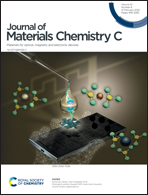Facile generation of thenil and furil based blue emitters for the fabrication of non-doped and solution-processed light-emitting electrochemical cells†
Abstract
Environmentally sustainable, energy-efficient and economical devices have drawn great attention and are considered to be the future of artificial lighting device market. Taking this into account, we have designed and generated rare metal-free, solution processable and non-doped light emitting electrochemical cells (LECs) composed of two new donor (D)–acceptor (A) type blue emitting ionic organic small molecules with a combination of thenil and furil imidazole coupled triphenylamine. These emitters exhibited blue luminescence in both solution and thin film states, with excellent thin film formation capability and thermal stability, along with good solubility in most of the common organic solvents. These solution-processed LEC devices delivered uniform blue emission of maximum brightness of 720 and 690 cd m−2, with maximum current efficiencies of 1.98 cd A−1 and 1.47 cd A−1, and power efficiencies of 0.72 lm W−1 and 0.61 lm W−1 for ThAm and FuAm, respectively. In addition, it is remarkable that these emitters display excellent emission without any additional host materials or ions.



 Please wait while we load your content...
Please wait while we load your content...